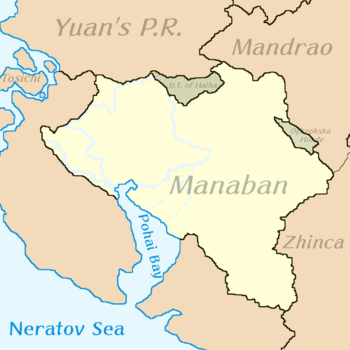Manaban
Manaban
Officially the National Republic of Manaban , is a country in Southwestern Ausiana, bordering north to Yuan, The unincorporated territories of Haiha and Mandrao. To the East with Mandrao, The Opkepkska Horde; Zhinca, and to the south with the Neratov Sea and Pohai Bay. Encompassing almost a million square kilometers (exactly 900,000 sq km) it is considered a fair-sized country inside of its native continent, ruled by the Ausiana Identity Coalition (澳西阿那身份聯盟) leadered by Prime Minister Zi Sirin Gioro.
Nationalist Republic of Manaban ᠮ᠊ᠠᠨ᠊ᠠᠪ᠊ᠠᠨᠨ᠋ ᡬ᠊᠊ᡠᠪ᠊ᠴ᠊ᡳ᠋ ᡳ᠊᠊ᡵ᠊ᡬ᠊᠊ᡝ᠊ᠨ᠋ ᡬ᠊ᡠ᠊᠊ᡵ᠊᠊ᡠ᠊ᠨ᠋ / Gubcin Irgen Manaban Gurun
滿阿半國民共和國/ Mǎnābàn guómín gònghéguó Үндэсний Бүгд Найрамдах Улс / Ündesniibügd Nairamdakhuls | |
|---|---|
|
Flag | |
| Motto: "Mini Mafa Gurun" | |
| Anthem: Yellow and purple fields | |
 | |
| Capital | Changhua |
| Largest city | Zihai'an |
| Official languages | Mannese, Southwestern Yauneze, Mingonian, Belogorskovi |
| Ethnic groups | Mannese, Yuaneze,Mingonian, Beleroskovi |
| Government | Assymetrical federalist parliamentary government |
• Prime Minister | Zi Sirin Gioro |
| Currency | (Mannese Yen) (滿元 (MBY)) |
| Calling code | +686 |
| Internet TLD | .mb |
Prehistory
There is registry about a newly discovered culture now baptized as the Guihai river civilization which dates to at least 45,000 years. Truly one of the most ancient traces of human organization in all of Manaban's territories. Though these are only remainders of it, like small, previously unidentified huts not compatible with any of the region's cultures and other items like clay pots and wooden pipes. Manaban
Prehistoric Geography
Mannese lands used to be different to today's landscapes are. Approximately 45 million years ago, Manaban was mostly formed by a chain of islands which paleontologists have named the Sohontu Archipelago. The place that resembles these islands the most in current times is the westernmost wetlands of the Hugong river delta.
Prehistoric Fauna
Some of the most recently discovered animals in the Sontohu Archipelago are the Sabuharaptor, a mid-sized opportunist scavenger from the late periods. Its name literally means Saw thief.
Mudurisaurus, which is a large carnivorous draconic quadruped reptilian that dwelled in the warm tropical forest glades. Its fossils might be the reason why Mannese people are obsessed with dragons. So far, only 4 specimens have been registered.
And Akjanodon; literally thundertusk is the male characteristic for which they've been known. It's speculated these gigantic tusks were used to fend the carnivorous competition. One of the most competent animals of its era which was a marsupial rather than a reptile.
All of these animals are from different periods of time and islands.
Modern History
Culture
Quirky Ghost Festival
The Quirky Ghost Festival (古怪鬼节 Gǔguài guǐ jié) is a syncretized tradition where several Mannese ethnicities gather together to remember their ancestors and honor them.
At dusk, blue and purple candles and paper lanterns are lit due to the fact that, in Manaban this combination simbolizes the past and the non-living.
The event occurs on the first week of the tenth month of the Ausianan calendar. Though the whole week is celebrated, only the only day off given by employers is friday.
People tend to prepare, eat and sell meals on the streets, setting up pasar malams (or Yeshi 夜市) to enjoy several traditional yauneze and mannese dishes.
Olonkho
Olonkho is an ethnic Mannese part of the oral tradition of Guguai guijie, followed right after the dinner in pasar malams in which important events of the current years are related as a song by a narrator. More elaborated Olonkho include actors with dialogues and an entire plot for a well condensed play. Olonkho may last somewhere between 2 to 6 hours and due to the fact of being hours long it makes Olonkho use several breaks and it is considered an honor to participate in one, there is a personnel of yearly volunteers that fill in the most important characters; secondary characters are selected through a raffle.
It is said to be originated in central Ausianan steppes' oral song tales of the same kind, passed down by merchants and thus explaining why it always comes after the market-like dinner. It is known by the same name and most of the details are kept the same.
Soidu
Literally Omen shift is yet another Mannese ethnical practice adopted nationwide. It consists in a superstitious curfew, for fear of encountering a ghost without carrying an offering for it.
Though it's never been registered to be mandated by the state, many people leave the streets after 11:00 PM during these dates unless a yaya hacin is worn. Yaya hacin comes from Mannese and it means any kind of-, whatever kind of-. for these dates, it is an amulet that is needed in order to protect from ghostly presences and being haunted by them.
Offerings
Offers to the diseased are set in public places including things such as food, cigars, incense, and music through the previously mentioned Olonkho and the more recently incorporated Getai. It is important to mention that leftovers, badly played Olonkho and Getais are frown upon to be received as an offering.
People is used to gift away these kind of items because unlike money and physical objects, food and songs can be compared more to events with an essence that can be consumed by spiritual beings, though some people in the southern regions do burn hell money for their ancestors to stay longer, as a bribe to the underworld gods.

